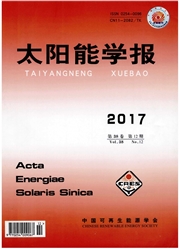

 中文摘要:
中文摘要:
利用浸渍法和沉淀法分别制备了Ni/Al2O3(NiAII)和Ni/白云石(NiDoP)两类生物质气化催化剂,采用氢气还原热重实验和固定床气化实验对两类催化剂进行性能验证,分析了催化剂制备方法、活性组分、还原温度、负载量、还原度、比表面积等因素对气化效果的影响。结果显示沉淀法制备的NiDoP中Ni以Mg0.4Ni0.60固溶体形式存在,其适宜的还原温度范围为400-600℃,浸渍法制备的NiAlI中Ni以NiAl2O4形式存在,其适宜的还原温度范围为800—900℃。500℃还原后的20NiDoP较20NiMI具有更好的催化性能,900℃时20NiDoPA催化下的氢产率达34mol/(kgdaf),碳转化率达96%。添加5%K2CO3改性后的20NiDoP催化剂中,K2O在气化过程中起了显著的催化作用。此外,在生物质气化催化剂制备过程中需综合考虑比表面积和负载量的相互关系。
 英文摘要:
英文摘要:
Two types of biomass gasification catalysts (Ni/dolomite and Ni/Al2O3) were prepared by impregnation and precipitation methods, respectively. The performance of catalysts verification experiments were carried out by using of H2- TGA and fixed bed gasifier. And the effects of the factors such as catalyst preparation methods, active components, reduction temperature, loading amount, reduction degree and specific surface area were analyzed. The results showed that the Mg0.4 Ni0.6 O structure is formed in the Ni/dolomite (NiDoP) catalyst prepared by precipitation method, and its suitable reduction temperature range was 400-600℃, while the NiAl2O4 structure is formed in the Ni/Al2O3 (NiAII) catalyst prepared by the impregnation method, and its reduction temperature range is 800-900℃. 20NiDoP reduced at 500℃ had a better catalytic performance than 20NiAlI, the H2 yield reached 34mol/(kg daf), and the carbon conversion rate reached 96% with the 20NiDoPA catalyst at 900℃ K20 in 20Ni5KDoPB catalyst modified by adding 5% K2CO3 played a remarkable role in the gasification process. In addition, the relationship between the specific surface area and loading amount should be significantly considered in the biomass gasification preparation process.
 同期刊论文项目
同期刊论文项目
 同项目期刊论文
同项目期刊论文
 Simulation of hydrogen production from biomass gasification in interconnected fluidized beds,Biomass
Simulation of hydrogen production from biomass gasification in interconnected fluidized beds,Biomass Flow behaviors of a large spout-fluid bed at high pressure and temperature by 3D simulation with kin
Flow behaviors of a large spout-fluid bed at high pressure and temperature by 3D simulation with kin Hydrodynamic characteristics of spout-fluid bed: Pressure drop and minimum spouting/spout-fluidizing
Hydrodynamic characteristics of spout-fluid bed: Pressure drop and minimum spouting/spout-fluidizing 期刊信息
期刊信息
